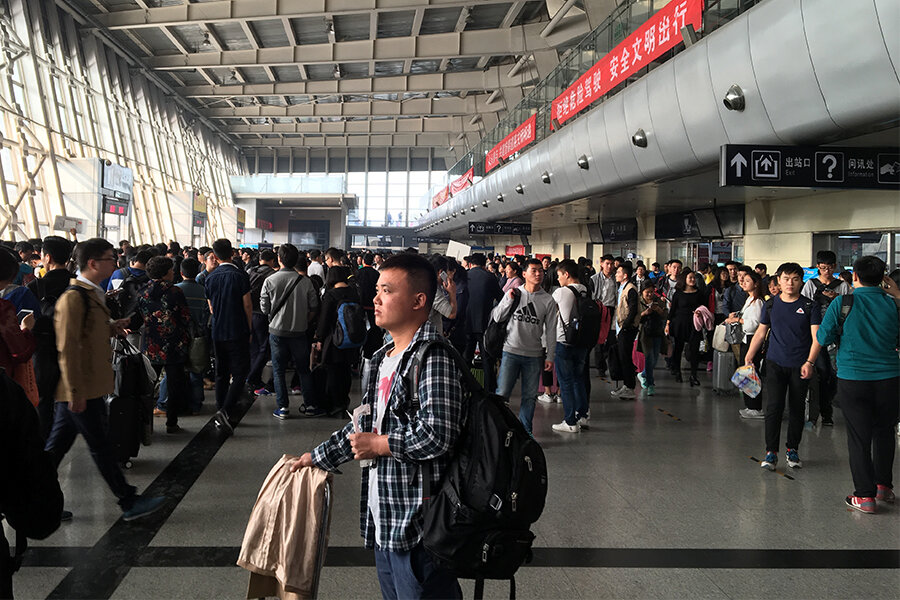Despite travel frenzy, a newcomer finds luster in China's Golden Week
| Hohhot, China
I was prepared for the worst when Gao Yuqi and I reached the bus station in southwest Beijing.
It was Saturday, the first day of the week-long National Day holiday, and I had been warned about the annual Golden Week travel frenzy. A newly arrived correspondent in this nation of 1.4 billion people, I was not acquainted with the idea of an entire population hitting the open road at once.
The day before, I had gone to Beijing’s central train station to see it for myself. I watched from outside as a sea of people poured out in waves and thousands of outbound passengers jostled for position in lines that stretched for hundreds of feet.
Saturday was no different. By 9 a.m. a flurry of people were shoving down stairs, balancing luggage and boxes filled with gifts for families back home. As we made through the security check, I quickly learned that maneuvering crowds in China was a contact sport. Bumping shoulders was unavoidable, as was getting sideswiped by backpacks and duffle bags.
To my surprise, we managed to board our bus five minutes before its 9:30 departure. But that was only the first obstacle, and a rare moment of efficiency. Next came the traffic, which didn’t take long to turn into a crawl.
“How’s the traffic?” a friend in Beijing texted me at 11:41. “Still in Beijing?”
By then we had in fact made it out of the city, but just barely. Yet we were surely making better progress than the Beijing drivers who reportedly took six hours to drive 60 miles out of the city – to say nothing of the hundreds of people who were stranded Monday night on a mountain in Shaanxi province after heavy winds caused cable car service to shut down.
We arrived at our destination – Hohhot, the capital of Inner Mongolia in north-central China – at 6:30 p.m., a mere two hours behind schedule.
It likely helped that rather than follow the millions of tourists south to places like the new glass-bottomed suspension bridge in Zhangjiajie or Hangzhou’s West Lake, which was expecting a tourism spike courtesy of the G-20 summit, I traveled north with Yuqi, a friend from Beijing, to visit her family in Hohhot.
A respite from work, if not crowds
The Golden Week holiday, which celebrates the Communist founding of the People’s Republic of China in 1949, is designed to stimulate domestic tourism spending. But more importantly, it provides the country’s massive labor force with a rare respite from their daily grinds in factories and office towers. With vacation time limited and working-age adults often far away from home, it’s one of the few times a year they have the chance to see family, the traditional cornerstone of Chinese life.
The numbers are mind-boggling. Nearly half of China, about 590 million people, were expected to travel during this past week’s National Day holiday, according to a recent report from the China Tourism Academy. That’s more people than live in all of North America and a 12 percent increase compared with last year.
The report estimates Chinese tourists will spend a combined $71.7 billion this week, 13.5 percent more than last year, making the tourism industry a bright spot amid China’s economic slowdown. Domestic tourism generated about $620 billion last year, with more than 4 billion trips taken.
Nationwide, tourism spending already rose 16.1 percent year-over-year to $12.7 billion on Sunday, reports the China National Tourism Administration.
It’s the kind of growth the government is eager to see, says Xu Hong, associate director of the College of Tourism and Service Management at Nankai University in Tianjin. As policymakers try to shift the economy’s focus from manufacturing and exports to services and consumption, they’re hoping the tourism industry will help lead the way.
“Tourism plays a very important connecting role in the economy,” Prof. Xu says. “It acts as a pulling force that helps other industries develop.”
Although Inner Mongolia is far from a tourism hotspot in China, the Golden Week effect could be seen at work in Hohhot.
On Sunday, we wandered around the city’s ancient Buddhist temples and stupas before making our way to its central shopping district. The temples’ courtyards were packed with selfie-taking tourists, and the shops and restaurants were filled. Thousands of young people had returned from Beijing to explore their hometown’s historical sites and to take advantage of Hohhot’s considerably lower prices.
“Tourism has become a part of people’s lives,” Xu had told me. I soon realized this was as true in Beijing and Shanghai and as it was in a far-flung city that had sprouted from the grasslands of Inner Mongolia.





